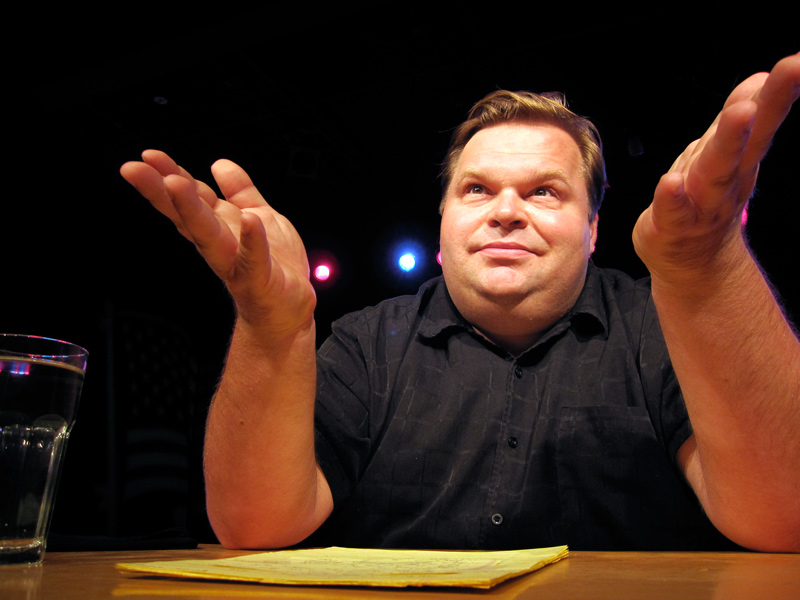Daisey on Stage
Mike Daisey had performed monologues since 1997, but first received critical acclaim in February 2001 for his one-man show, 21 Dog Years: Doing Time @ Amazon.com , about his three years working at the Seattle company. That August, it won best solo show at the New York Fringe Festival and had a six-month run off-Broadway. By 2012, Daisey had created 15 one-man shows that, according to the New York Times , blended “personal stories, historical digressions and philosophical ruminations.” [7] Each of his monologues, which were quasi-scripted, featured Daisey sitting behind a table with a glass of water and a pad of paper on an otherwise bare stage. His collaborator, Jean-Michele Gregory, was also his director.
In 2006, Daisey performed Truth about author James Frey’s embellished memoir, A Million Little Pieces . As one theater critic reported: “During his monologue, Daisey admits to once fabricating a story because it ‘connected’ with the audience.” [8] The article continues:
After telling this lie over and over, he recalled, it became so integrated into the architecture of his piece that it became impossible to remove or to distinguish from what had really happened. Daisey seemed embarrassed by this confession, but he also pursued the issue to ask whether lying was acceptable in the service of a greater truth. What, he asked, did truth mean in the context of art?
His other monologues included Monopoly , about the conflict between Nikola Tesla and Thomas Edison over electricity; Great Men of Genius , the interwoven biographies of four famous megalomaniacs; and The Last Cargo Cult , about Daisey’s encounter with natives on a remote South Pacific island who worshipped America and its cargo. Glass first saw Daisey perform in If You See Something Say Something , which opened in New York in 2008. In it, Daisey told the history of the US Department of Homeland Security, discussed the life of the father of the neutron bomb, and described his visit to the Trinity blast site, where the first atomic bomb was tested in 1945.
In June 2010, Daisey, a lifelong Apple fan, traveled to Shenzhen, China, for a six-day trip. He wanted to gain access to the Foxconn factory, which manufactured electronics products for Apple, Dell, Nokia, Panasonic, Sony and many more. “I don’t do monologues unless there’s something compelling in collision with something else in my life,” Daisey said.
There was really nothing to [say about [Apple] until a couple of years ago, when I started reading and learning about the working conditions in southern China and investigating the supply chain. [9]
Daisey hired a translator, Cathy Lee, to help him interview workers at the gates of the Foxconn factory (the factory’s Apple assembly lines were off-limits to reporters). [9] “At this plant, they make all kinds of things, including MacBook Pros and iPhones and iPads. And so my plan [was] to take this taxi to the main gate and talk to anybody who wants to talk to me,” Daisey said. [10] Daisey said that when he met Lee two days later in the hotel lobby, he told her that he wanted to visit other factories as well, and would pretend to be an American businessman to gain access.
On returning to New York, Daisey started work on his next monologue, The Agony and the Ecstasy of Steve Jobs , based in part on his interviews and experiences in China. Among the China observations that Daisey included were guards with guns at the entrance to Foxconn; a taxi driver who accidentally took an exit ramp that stopped, unfinished, in midair; excerpts from his interviews with nearly 100 workers at the Foxconn gates; a tour of a different factory a few days later; and interviews with 25-30 workers, including members of an illegal union, at a café (the union members told him they met regularly at a Starbucks coffee shop). [11]
The show, billed as a work of nonfiction, was booked for the Public Theater’s 2011-2012 season. By coincidence, Steve Jobs, who had pancreatic cancer, died on October 5, 2011, a week before opening night. Daisey’s monologue was such a hit that its run was extended beyond the original November 13 closing to March 18, 2012.
[7] Jason Zinoman, “The Need to Think Onstage is Driving Mr. Daisey,” New York Times , January 21, 2007.
[8] Jason Zinoman, “Telling Tales About the Past, and Maybe Fudging Facts,” New York Times , October 11, 2006.
[9] Catherine Rampell, “A Trip to China Can Make a Guy Hate his iPhone,” New York Times , September 29, 2011.
[10] In late January 2012, ABC News’ Bill Weir became the first journalist allowed to visit the Apple production lines at Foxconn. See: http://abcnews.go.com/blogs/technology/2012/02/foxconn-apple-and-the-fair-labor-association-respond-to-abc-news-exclusive-report/ . A British journalist ( The Mail ) reportedly visited the Shenzhen Foxconn factory secretly in 2006. Source: Charles Duhigg and David Barboza, “In China, Human Costs Are Built Into an iPad,” New York Times , January 25, 2012. See: http://www.nytimes.com/2012/01/26/business/ieconomy-apples-ipad-and-the-human-costs-for-workers-in-china.html?pagewanted=all
[11] Episode 454, This American Life , January 6, 2012.
[12] Ibid.
